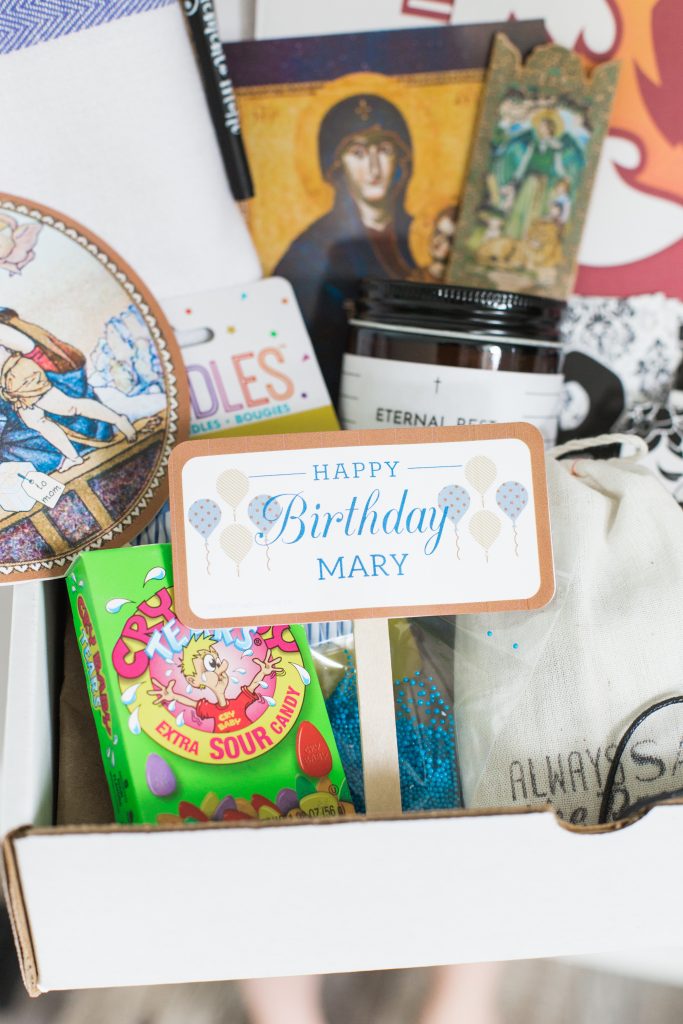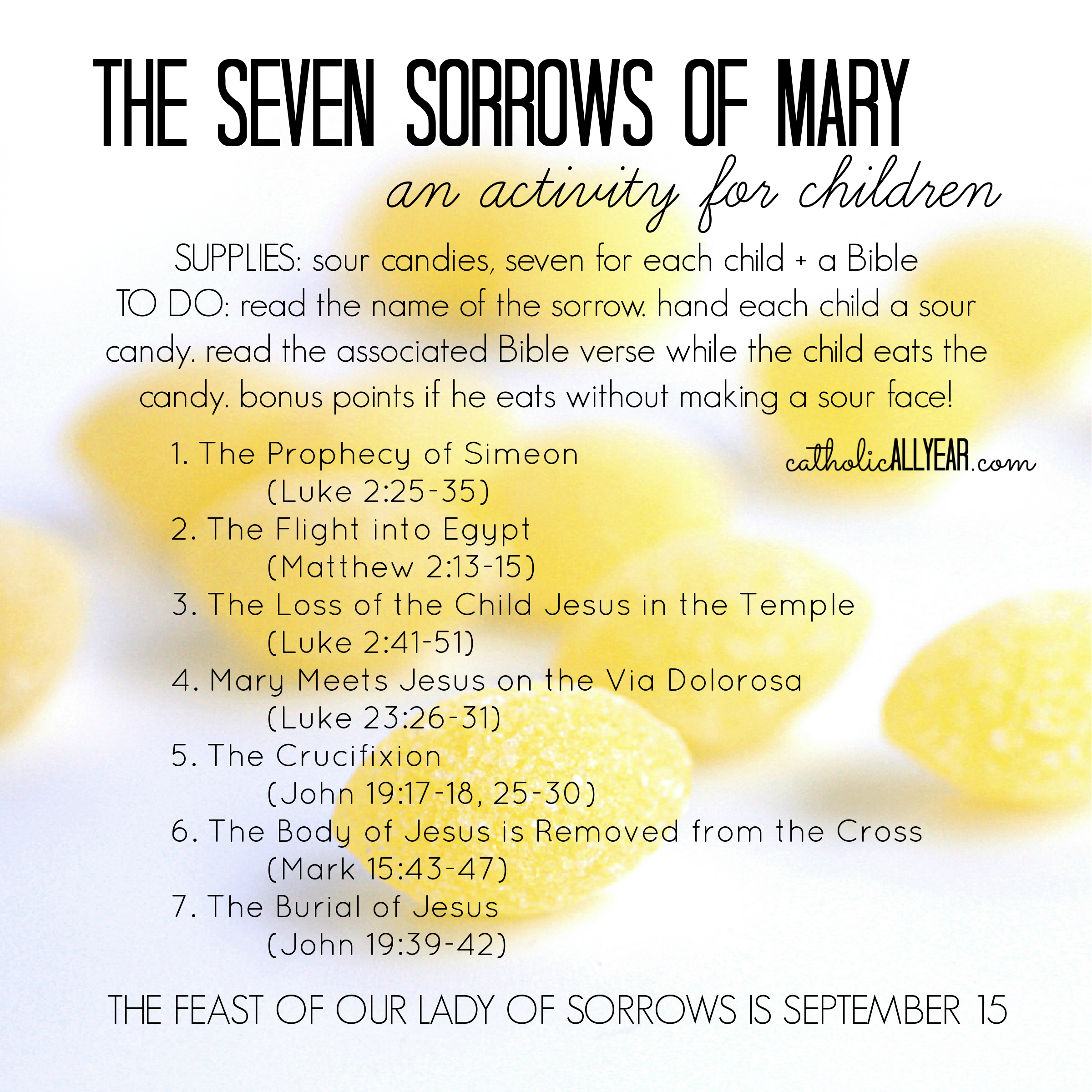Hey all! It’s September, the month of the Seven Sorrows of Mary, and the feast of Our Lady of Sorrows is coming up on September 15. And while “The Seven Sorrows” might not sound like a lot of fun . . . I’m here to try to convince you that it’s a devotion worth practicing and that, yes, it CAN be fun.
Here it is in video format:
Stay tuned to the end of the show for this month’s 25% off book recommendations!
Ignatius Bible (RSV), 2nd Edition – Leather
New Testament: Ignatius Catholic Study Bible
Saint Joseph: Watch Over My Family
Saint Thérèse of Lisieux: Living on Love
Get 25% off any or all four of these books through the end of October at www.ignatius.com with the code CAY921
Books by @Ignatius_Press
Video by Jack & Bobby Tierney
That’s right, the Tierney teenagers have taken over behind the camera and behind the scenes around here, at least temporarily. Please keep our usual CAY filmmaker Elizabeth Mirzaei and her family and their other home, Afghanistan, in your prayers.
So let’s talk about . . . the Seven Sorrows of Mary: what they are, why Catholics make a point of remembering them, and I’ll share our family activity in honor of Our Lady of Sorrows that combines looking up scripture verses and eating sour candy . . .
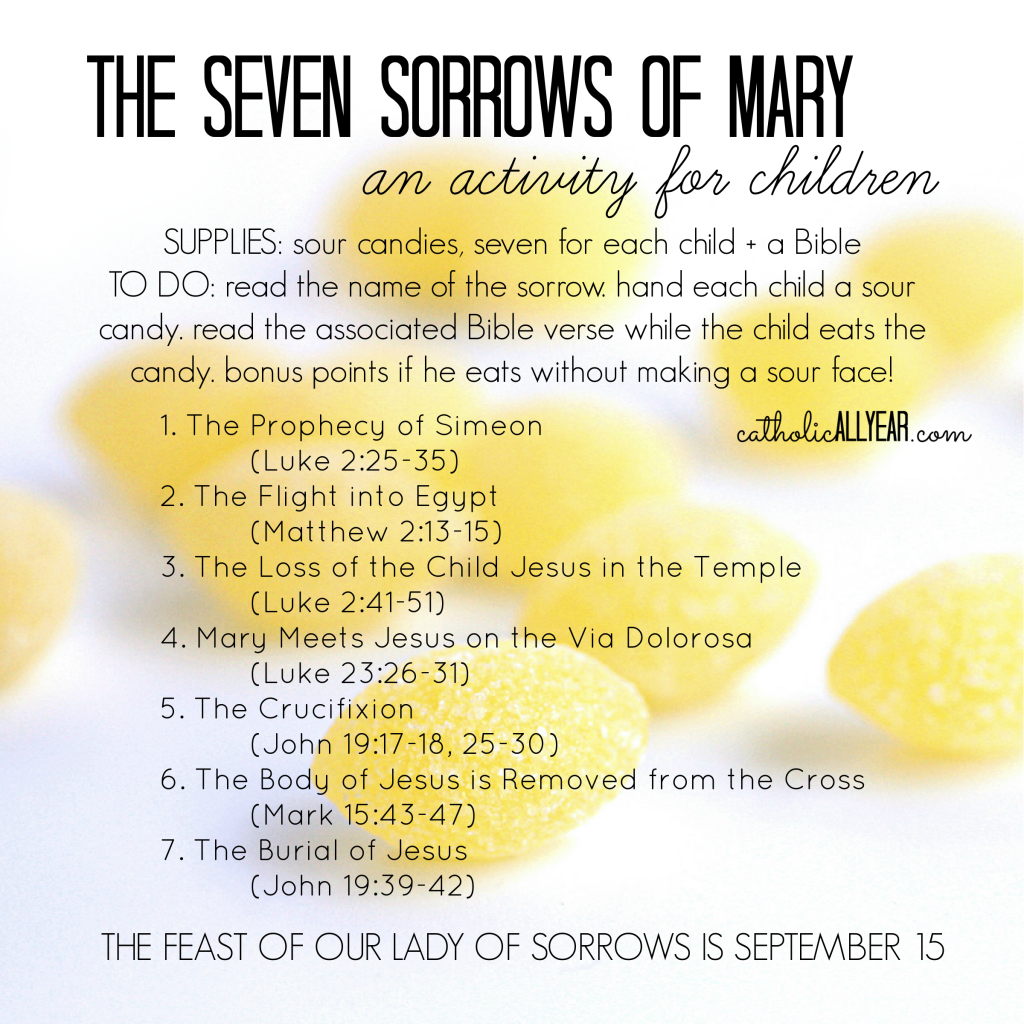
Veneration of Our Lady of Sorrows can be traced back to Benedictine monks in the eleventh century, and grew in popularity through the late middle ages with devotions like the Rosary of the Seven Sorrows and the black scapular. The devotion was promoted by the Servite Order, and Saint Bridget of Sweden, among other saints.
The Seven Sorrows of Mary are seven sad events that occurred in the life of Our Lady, and are recorded in the Bible. The sorrowful mysteries of the rosary overlap some with the Seven Sorrow, but that’s a different devotion.
Our Lady of Sorrows is a popular subject in Christian art. The image of “Mater Dolorosa” can often be seen with swords or daggers piercing Mary’s chest or heart, based on the words of the prophecy of Simeon (itself one of the sorrows), “and you yourself a sword will pierce so that the thoughts of many hearts may be revealed”.
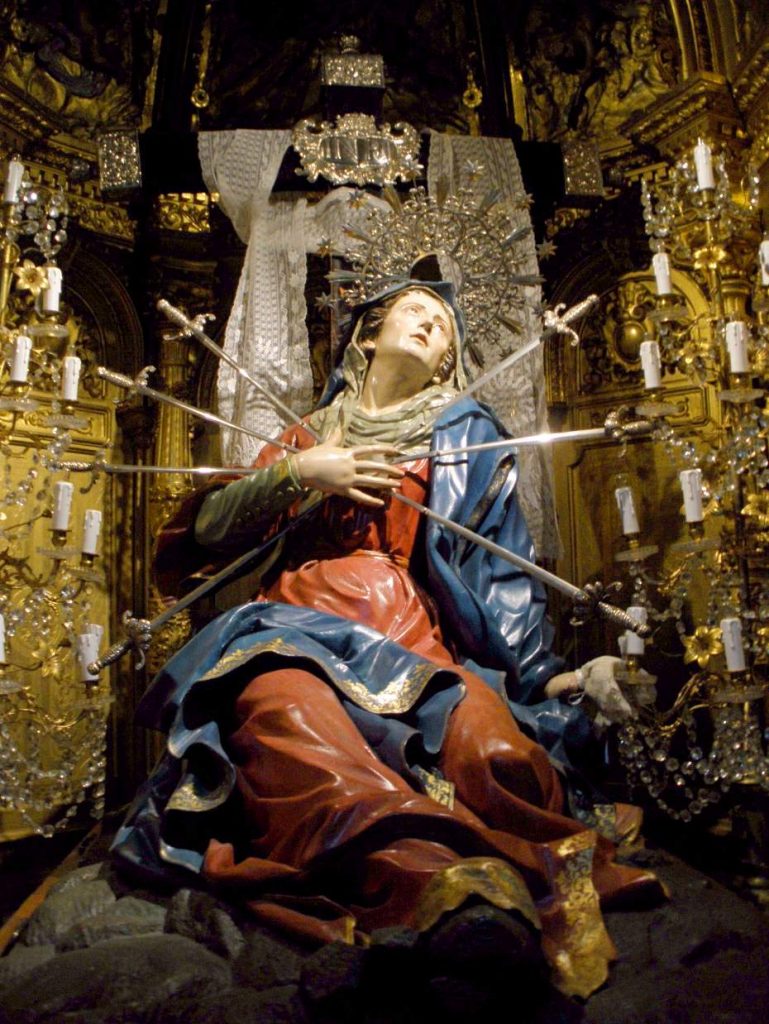
We can also see her in art as the Stabat Mater or “standing mother” next to the cross of Jesus (and of course that’s also a beautiful hymn).

And the pieta, in which Our Lady holds the body of Jesus after he is removed from the cross.
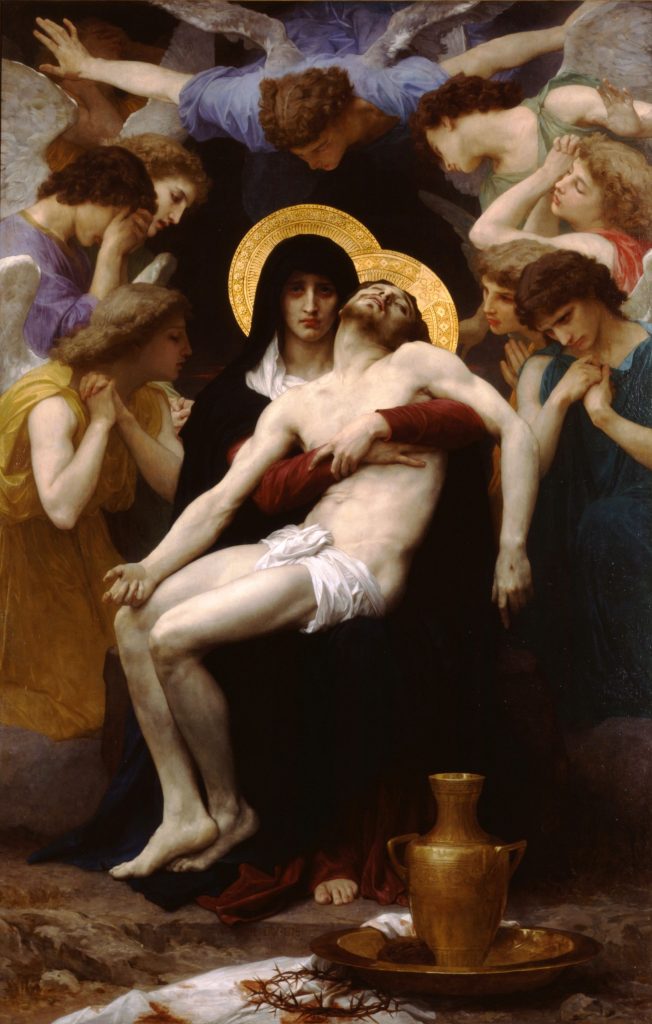
So . . . why do Catholics venerate Our Lady in her Sorrows? It’s a way that we can identify with our Lady, who very often, and rightly, seems out of reach for us. But even though she is sinless and perfect and the mother of God, we know that she can understand and empathize with our sufferings because she herself suffered. Our Lady of Sorrows is a good reminder that, just like the country song, Jesus never promised us a rose garden. His mother Mary was spared original sin, but not suffering. The greatest saints have had great sorrows. Our devotion to God and our faithfulness to the Catholic Church doesn’t promise us material wealth or a life free of suffering on earth. It promises us the chance for true joy and meaning in our lives on this earth, despite our hardships, and eternal happiness with God in heaven when this life is over.
The most important part of this—or any—devotion to Our Lady is that it points us to Christ.
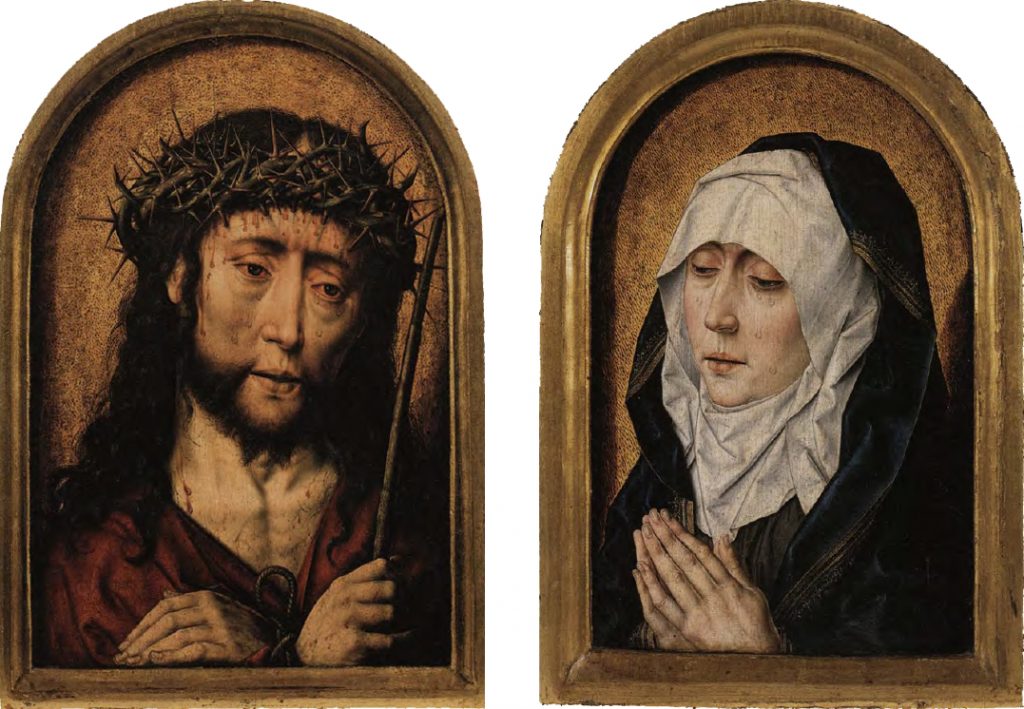
When it was first instituted as a feast day on the church liturgical calendar in the fifteenth century, it was called The Feast of Our Lady of Compassion. This title really highlights the reason why Catholics venerate Our Lady in her Sorrows. It was her compassion for the suffering her son would endure that was her true sorrow. Mary suffered for Jesus and with Jesus, because of her great love for him. The Church gives us Our Lady of Sorrows as an example of Mary’s faithfulness.
She was faithful when it was confusing, like the prophecy of Simeon, and when it was inconvenient like the flight into Egypt, and when it was infuriating like the loss of the child Jesus in the temple, and when it was utterly heartbreaking during the Way of the Cross and the passion and death of Our Lord. Through it all, she was faithful, and that’s what we hope to emulate when we practice a devotion to her seven sorrows.
Since the seven sorrows of Mary can be found in the Bible, our family activity for the day is to read the scripture passage associated with each sorrow aloud. The scripture passages can be found in The Catholic All Year Prayer Companion, and monthly prayer booklets, or if you want to level up, this is a great chance to practice looking up Bible verses.

“Matthew, Mark, Luke, and John, you saddle the horse and I’ll jump on”
To make it even more fun, we meditate on each sorrow . . . . while eating something sour, and trying NOT to make a sour face.

The challenge is to think about how Mary would have felt during that experience, and be eating the sour candy, and NOT make a sour face. Because, as we know, she did not make faces: “Mary kept all these things, pondering them in her heart” (Lk 2:19). It manages to be somber and slightly hilarious at the same time.

The Seven Sorrows of Mary: an activity for children
SUPPLIES: sour candies, seven for each child + a Bible and/or CAY Prayer Companion
TO DO: read the name of the sorrow. hand each child a sour candy. read the associated Bible verse while the child eats the candy. bonus points if he eats without making a sour face!
- The Prophecy of Simeon
(Luke 2:25-35) - The Flight into Egypt
(Matthew 2:13-15) - The Loss of the Child Jesus in the Temple
(Luke 2:41-51) - Mary Meets Jesus on the Via Dolorosa
(Luke 23:26-31) - The Crucifixion
(John 19:17-18, 25-30) - The Body of Jesus is Removed from the Cross
(Mark 15:43-47) - The Burial of Jesus
(John 19:39-42)
THE FEAST OF OUR LADY OF SORROWS IS SEPTEMBER 15, and the whole month of September is devoted to the Seven Sorrows of Mary.
You can find out more about liturgical living in the home and Catholic traditions like the Seven Sorrows in The Catholic All Year Compendium
And find prayers and scripture readings for feast days in The Catholic All Year Prayer Companion.
Get printable liturgical living resources for September with a Catholic All Year Membership.
Get the Catholic All September booklet here.
And if you have the Catholic All Year Liturgical Living Box for Fall, you’ve got some super sour candies in there ready to go!
